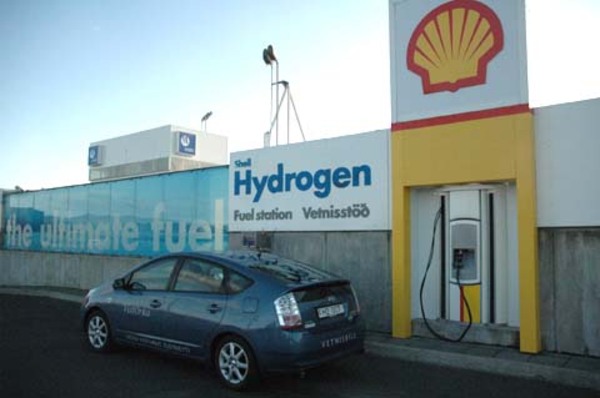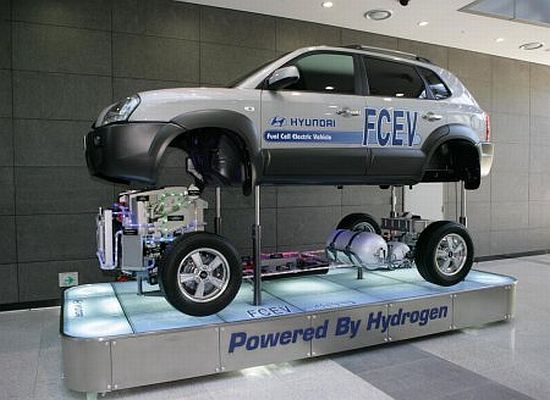News
Are hydrogen cars competition for Tesla?

Reading the news and making sense of PR pitches is an art and a science. The art is reading through the pitches, determining where the motivation is and what lies behind. The science is re-articulating the message behind pitches. The latest news campaign is that hydrogen fuel cells cars are competition to Tesla and electric vehicles (EV).
Sifting through the news
Are hydrogen fuel cell cars competition to EVs? And if so, how are they competing? Those are basic, relevant questions we need to keep in mind when reading the news. Matthew Levy on Seeking Alpha believes Toyota and Hyundai’s hydrogen fuel cell vehicles compete with the Model S. The truth is, Toyota and Hyundai are not in the same league as Tesla Motors in terms of their respective segments and innovations.
The article tries to make a point that by opening the doors to its charging protocols, Tesla won’t sue those who use these protocols in good faith. The article argues that Tesla’s new competitors are growing, but include the Detroit VIA Motors that converts pickup trucks to plug-in hybrids (PHEV) and Harley-Davidson’s new and loud Project LiveWire, a noisy electric motorcycle I covered on CarNewsCafe. According to Matthew Levy: “While these are not direct competitors to Tesla’s sedans, they do show the shift in attention to electric vehicles. Combined with Chevrolet’s Volt (GM) and the Nissan Leaf, the electric vehicle market is becoming crowded behind Tesla. With the availability of Tesla’s patents to other electric vehicle manufacturers (who have more resources than Tesla), the gap should continue to shrink.”, indeed, it will and it should. No one would argue that, least of all Elon Musk.
 The article points to a theoretical advantage Tesla has over the competitors. “With the same driving range on the upgraded models,” we suppose the article refers to the P85, “as well as much longer charging times,” larger tanks take longer to fill as well, “the Model S only holds a slight advantage over its hydrogen competitors, if any.” Really? How so? Try an encyclopedia of advantages. It is a full electric vehicle that comes with the freedom of choice of accepting your very own home 110V outlets, your dedicated 240V plug, your home high-powered Tesla charger, the option for the free Supercharger, depending on your time to recharge and where you are. Now, add to this the fact that you and I can make electricity from solar energy, wind, hydro, and any other alternative and renewable energy, or simply just plug it in anywhere.
The article points to a theoretical advantage Tesla has over the competitors. “With the same driving range on the upgraded models,” we suppose the article refers to the P85, “as well as much longer charging times,” larger tanks take longer to fill as well, “the Model S only holds a slight advantage over its hydrogen competitors, if any.” Really? How so? Try an encyclopedia of advantages. It is a full electric vehicle that comes with the freedom of choice of accepting your very own home 110V outlets, your dedicated 240V plug, your home high-powered Tesla charger, the option for the free Supercharger, depending on your time to recharge and where you are. Now, add to this the fact that you and I can make electricity from solar energy, wind, hydro, and any other alternative and renewable energy, or simply just plug it in anywhere.
These are huge advantages hydrogen does not offer yet. Using hydrogen, we go back to the pump and are not in control of the energy price. To be fair, utilities are slowing down personal alternative energy systems and are trying to inflate energy prices, but almost anyone can choose which energy origin to use for their EVs. If you don’t like the grid, install an alternative energy system at home. The same can’t be said about hydrogen fuel cell. I can build an electric motor or buy one on the cheap, I can’t do the same with a fuel cell. EVs offer energy choice, hydrogen does not yet.
The hidden message and the driving motivation
It is obvious by now that the hydrogen phenomenon hasn’t taken the world by storm. Contrary to the article, Hyundai already has a hydrogen fuel cell vehicle offered to the public and Honda has had its Clarity for lease since 2008. Hydrogen fuel cell has its place in the world of energy, but so far it’s been limited to places where solar panels have limited application without better energy storage. Who is driving the push for hydrogen fuel cells when we already have proven EVs, such as the Model S that uses commodity batteries and achieves close to 300 miles? The question to ask is who has benefited the most from the automobile this past century.

News
Tesla China delivery centers look packed as 2025 comes to a close
Needless to say, it appears that Tesla China seems intent on ending 2025 on a strong note.

Tesla’s delivery centers in China seem to be absolutely packed as the final days of 2025 wind down, with photos on social media showing delivery locations being filled wall-to-wall with vehicles waiting for their new owners.
Needless to say, it appears that Tesla China seems intent on ending 2025 on a strong note.
Full delivery center hints at year-end demand surge
A recent image from a Chinese delivery center posted by industry watcher @Tslachan on X revealed rows upon rows of freshly prepared Model Y and Model 3 units, some of which were adorned with red bows and teddy bears. Some customers also seem to be looking over their vehicles with Tesla delivery staff.
The images hint at a strong year-end push to clear inventory and deliver as many vehicles as possible. Interestingly enough, several Model Y L vehicles could be seen in the photos, hinting at the demand for the extended wheelbase-six seat variant of the best-selling all-electric crossover.
Strong demand in China
Consumer demand for the Model Y and Model 3 in China seems to be quite notable. This could be inferred from the estimated delivery dates for the Model 3 and Model Y, which have been extended to February 2026 for several variants. Apart from this, the Model Y and Model 3 also continue to rank well in China’s premium EV segment.
From January to November alone, the Model Y took China’s number one spot in the RMB 200,000-RMB 300,000 segment for electric vehicles, selling 359,463 units. The Model 3 sedan took third place, selling 172,392. This is quite impressive considering that both the Model Y and Model 3 are still priced at a premium compared to some of their rivals, such as the Xiaomi SU7 and YU7.
With delivery centers in December being quite busy, it does seem like Tesla China will end the year on a strong note once more.
News
Tesla Giga Berlin draws “red line” over IG Metall union’s 35-hour week demands
Factory manager André Thierig has drawn a “red line” against reducing Giga Berlin’s workweek to 35 hours, while highlighting that Tesla has actually increased its workers’ salaries more substantially than other carmakers in the country.

Tesla Giga Berlin has found itself in a new labor dispute in Germany, where union IG Metall is pushing for adoption of a collective agreement to boost wages and implement changes, such as a 35-hour workweek.
In a comment, Giga Berlin manager André Thierig drew a “red line” against reducing Giga Berlin’s workweek to 35 hours, while highlighting that Tesla has actually increased its workers’ salaries more substantially than other carmakers in the country.
Tesla factory manager’s “red line”
Tesla Germany is expected to hold a works council election in 2026, which André Thierig considers very important. As per the Giga Berlin plant manager, Giga Berlin’s plant expansion plans might be put on hold if the election favors the union. He also spoke against some of the changes that IG Metall is seeking to implement in the factory, like a 35-hour week, as noted in an rbb24 report.
“The discussion about a 35-hour week is a red line for me. We will not cross it,” Theirig said.
“(The election) will determine whether we can continue our successful path in the future in an independent, flexible, and unbureaucratic manner. Personally, I cannot imagine that the decision-makers in the USA will continue to push ahead with the factory expansion if the election results favor IG Metall.”
Giga Berlin’s wage increase
IG Metall district manager Jan Otto told the German news agency DPA that without a collective agreement, Tesla’s wages remain significantly below levels at other German car factories. He noted the company excuses this by referencing its lowest pay grade, but added: “The two lowest pay grades are not even used in car factories.”
In response, Tesla noted that it has raised the wages of Gigafactory Berlin’s workers more than their German competitors. Thierig noted that with a collective agreement, Giga Berlin’s workers would have seen a 2% wage increase this year. But thanks to Tesla not being unionized, Gigafactory Berlin workers were able to receive a 4% increase, as noted in a CarUp report.
“There was a wage increase of 2% this year in the current collective agreement. Because we are in a different economic situation than the industry as a whole, we were able to double the wages – by 4%. Since production started, this corresponds to a wage increase of more than 25% in less than four years,” Thierig stated.
News
Tesla is seeing a lot of momentum from young Koreans in their 20s-30s: report
From January to November, young buyers purchased over 21,000 Teslas, putting it far ahead of fellow imported rivals like BMW and Mercedes-Benz.

Tesla has captured the hearts of South Korea’s 20s-30s demographic, emerging as the group’s top-selling imported car brand in 2025. From January to November, young buyers purchased over 21,000 Teslas, putting it far ahead of fellow imported rivals like BMW and Mercedes-Benz.
Industry experts cited by The Economist attributed this “Tesla frenzy” to fandom culture, where buyers prioritize the brand over traditional car attributes, similar to snapping up the latest iPhone.
Model Y dominates among young buyers
Data from the Korea Imported Automobile Association showed that Tesla sold 21,757 vehicles to the 20s-30s demographic through November, compared to BMW’s 13,666 and Mercedes-Benz’s 6,983. The Model Y led the list overwhelmingly, with variants like the standard and Long Range models topping purchases for both young men and women.
Young men bought around 16,000 Teslas, mostly Model Y (over 15,000 units), followed by Model 3. Young women followed a similar pattern, favoring Model Y (3,888 units) and Model 3 (1,083 units). The Cybertruck saw minimal sales in this group.
The Model Y’s appeal lies in its family-friendly SUV design, 400-500 km range, quick acceleration, and spacious cargo, which is ideal for commuting and leisure. The Model 3, on the other hand, serves as an accessible entry point with lower pricing, which is valuable considering the country’s EV subsidies.
The Tesla boom
Experts described Tesla’s popularity as “fandom culture,” where young buyers embrace the brand despite criticisms from skeptics. Professor Lee Ho-geun called Tesla a “typical early adopter brand,” comparing purchases to iPhones.
Professor Kim Pil-soo noted that young people view Tesla more as a gadget than a car, and they are likely drawn by marketing, subsidies, and perceived value. They also tend to overlook news of numerous recalls, which are mostly over-the-air software updates, and controversies tied to the company.
Tesla’s position as Korea’s top import for 2025 seems secured. As noted by the publication, Tesla’s December sales figures have not been reported yet, but market analysts have suggested that Tesla has all but secured the top spot among the country’s imported cars this year.









